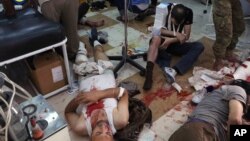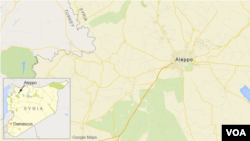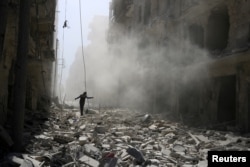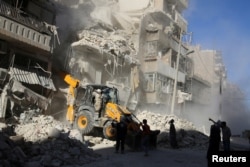The size of the bomb craters is becoming larger and the destructive power is growing of the missiles that Russian and Syrian government warplanes are launching at civilians and rebels in Aleppo.
Since the breakdown last week of a U.S.-Russia negotiated cease-fire in Syria, the ferocity of the onslaught on rebel-held eastern districts of Aleppo suggests Syrian President Bashar al-Assad and his overseas backers, Russia and Iran, are determined to overrun the insurgents in Aleppo, delivering a devastating blow to the five-year campaign to oust the Syrian strongman.
U.S. Ambassador to the United Nations Samantha Power accused the Assad regime on Sunday of mounting an “all-out offensive” to retake Aleppo.
Analysts and Western diplomats say in the past few weeks, Russian and Syrian warplanes have been pounding Aleppo with munitions designed to penetrate hardened military bunkers, not shallow cellars shielding civilians from round-the-clock airstrikes. They say the weapon of choice to subdue the eastern half of Syria’s once prosperous commercial capital is the bunker-busting BETAB-500 air bomb.
Advanced weaponry
A year ago, when Russia started its military intervention to prop up Assad’s then-floundering forces, Kremlin-controlled websites like Sputnik News boasted how the BETAB-500 air bombs were being “used in Syria to eliminate Islamic State command centers, which are multi-level underground bunkers made of reinforced concrete.”
On Sunday, U.N. Secretary-General Ban Ki-moon warned that the use of advanced weaponry and bunker-busters against civilians could amount to war crimes. He didn’t spell out the exact nature of the high-tech munitions that are inflicting a new hell on the war-exhausted civilians and rebels in Aleppo. Nor did he detail what precision air bombs like the BETAB-500 can do.
According to Robin Yassin-Kassab, Syrian activist and co-author of the book Burning Country, “Bunker busters dig five meters into the ground and can cause the collapse of three apartment buildings. They’re designed to destroy military bunkers. The Syrian regime and Russia are dropping these bunker busters on neighborhoods in Aleppo, killing entire families.”
Video footage posted online of craters in Aleppo are consistent with what would be expected to be seen from BETAB-500's, say military analysts. Their explosions send out powerful shockwaves, collapsing nearby buildings.
The 500-kilogram BETAB-500's have been used regularly by the Russians against the Islamic State terror group, as noted frequently by Russian military spokesmen.
On November 3, 2015, Colonel Igor Klimov, a Russian air force spokesman, told journalists in Syria, “Today, Russian strike aircraft used two BETAB-500 bunker buster bombs against ISIS targets.”
A few days later, Klimov assured Sputnik News, ”BETAB-500 bombs are used to destroy extremely protected and fortified underground bunkers; they are not dropped on cities.”
As the Russian news-site noted, “The concrete-piercing BETAB-500 bombs are equipped with a jet booster, which allows the bombs to completely destroy any underground installation.”
Families, clinics being shelled
The underground installations that have been hit in the past three days in an estimated 200 airstrikes are destroying basements where families are trying to shelter from the relentless air-raids, say local residents and aid workers. They are also striking makeshift clinics that have been set up in cellars.
On Friday, Russian and Syrian warplanes struck three of the four bases in eastern Aleppo of the White Helmets, the Syrian volunteer rescue group whose workers have been fearless in their efforts to tend to the injured. The group has been nominated for the Nobel Peace Prize. A rescue center was destroyed that was featured in a Netflix documentary about the organization and released earlier this month.
"You can see or hear groups of warplanes overhead the whole time," Zakaria Malahefji, an official with an Aleppo-based FSA [Free Syrian Army] militia, told VOA. "The earth shakes under the bombing."
A resident contacted by mobile phone described apocalyptic scenes: warplanes dropping an array of weaponry, from incendiary munitions and cheaply made barrel bombs — to smart, bunker-buster bombs — all crumpling and razing eastern Aleppo.
“There is not much you can do when you hear the jets; there’s nowhere that’s safe,” said Mohammed Ghassan, a father of two.
At the beginning of Russia's intervention, military analysts noted its warplanes were dropping more so-called "dumb" or gravity-dropping munitions without any guidance systems, like the high explosive FAB-500 bombs. As the intervention has progressed, laser and satellite-guided munitions have been launched in greater numbers, including KAB-500's.
Their effect on eastern Aleppo is clear to see; the weapons wiping out whole blocks are targeting key civilian and rebel infrastructure, from clinics and a water-pumping station to roads and local council buildings.
Since Friday, at least 200 civilians have died in the airstrikes, according to estimates from Syrian opposition and aid workers.
"The death toll is expected to rise because there are some people in critical situations, and due to missing people under the rubble," reported the pro-opposition monitoring group the Syrian Observatory for Human Rights.















